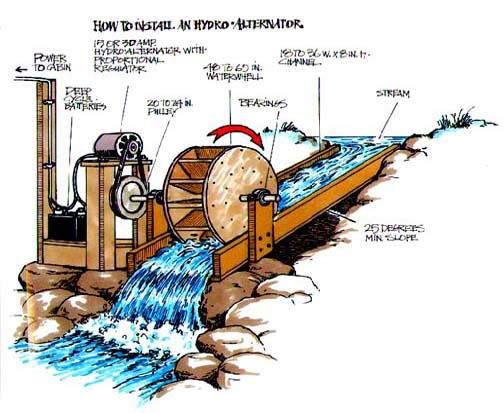
Waterwheels and mills
Hydropower has been used for hundreds of years. In India, water wheels and watermills were built; in Imperial Rome, water powered mills produced flour from grain, and were also used for sawing timber and stone; in China, watermills were widely used since the Han Dynasty. The power of a wave of water released from a tank was used for extraction of metal ores in a method known as hushing. The method was first used at the Dolaucothi gold mine in Wales from 75 AD onwards, but had been developed in Spain at such mines as Las Medulas. Hushing was also widely used in Britain in the Medieval and later periods to extract lead and tin ores. It later evolved into hydraulic mining when used during the California gold rush.

In China and the rest of the Far East, hydraulically operated "pot wheel" pumps raised water into irrigation canals. At the beginning of the Industrial revolution in Britain, water was the main source of power for new inventions such as Richard Arkwright's water frame. Although the use of water power gave way to steam power in many of the larger mills and factories, it was still used during the 18th and 19th centuries for many smaller operations, such as driving the bellows in small blast furnaces (e.g. the Dyfi Furnace) and gristmills, such as those built at Saint Anthony Falls, which uses the 50-foot (15 m) drop in the Mississippi River.
In the 1830s, at the peak of the canal-building era, hydropower was used to transport barge traffic up and down steep hills using inclined plane railroads.

Hydraulic power pipes
Hydraulic power networks also existed, using pipes carrying pressurized liquid to transmit mechanical power from a power source, such as a pump, to end users. These were extensive in Victorian cities in the United Kingdom. A hydraulic power network was also in use in Geneva, Switzerland. The world famous Jet d'Eau was originally the only over pressure valve of this network.

Compressed air hydro
Where there is a plentiful head of water it can be made to generate compressed air directly without moving parts. A falling column of water is mixed with air bubbles generated through turbulence at the inlet. This is allowed to fall down a shaft into a subterranean chamber where the air separates from the water. The weight of falling water compresses the air in the top of the chamber. A submerged outlet from the chamber allows water to flow to the surface at a lower height than the intake. An outlet in the roof of the chamber supplies the compressed air to the surface. A facility on this principal was built on the Montreal River at Ragged Shutes near Cobalt, Ontario in 1910 and supplied 5,000 horsepower to nearby mines.








0 comments:
Post a Comment